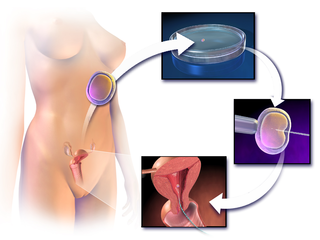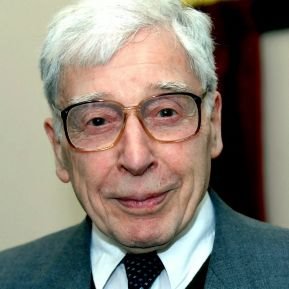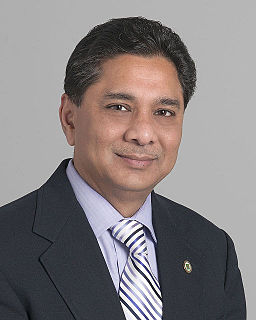
In vitro fertilisation (IVF) is a process of fertilisation where an egg is combined with sperm in vitro. The process involves monitoring and stimulating a person's ovulatory process, removing an ovum or ova from their ovaries and letting sperm fertilise them in a culture medium in a laboratory. After the fertilised egg (zygote) undergoes embryo culture for 2–6 days, it is implanted in a uterus, with the intention of establishing a successful pregnancy.

Patrick Christopher Steptoe CBE FRS was an English obstetrician and gynaecologist and a pioneer of fertility treatment. Steptoe was responsible with biologist and physiologist Robert Edwards and the nurse Jean Purdy for developing in vitro fertilisation. Louise Joy Brown, the first test-tube baby, was born on 25 July 1978. Edwards was awarded the 2010 Nobel Prize in Physiology or Medicine for his work on the development of in vitro fertilisation; Steptoe was not eligible for consideration because the Nobel Prize is not awarded posthumously.

Assisted reproductive technology (ART) includes medical procedures used primarily to address infertility. This subject involves procedures such as in vitro fertilization (IVF), intracytoplasmic sperm injection (ICSI), cryopreservation of gametes or embryos, and/or the use of fertility medication. When used to address infertility, ART may also be referred to as fertility treatment. ART mainly belongs to the field of reproductive endocrinology and infertility. Some forms of ART may be used with regard to fertile couples for genetic purpose. ART may also be used in surrogacy arrangements, although not all surrogacy arrangements involve ART.

Sir Robert Geoffrey Edwards was a British physiologist and pioneer in reproductive medicine, and in-vitro fertilisation (IVF) in particular. Along with the surgeon Patrick Steptoe, and the nurse Jean Purdy, Edwards successfully pioneered conception through IVF, which led to the birth of Louise Brown on 25 July 1978. They founded the first IVF programme for infertile patients and trained other scientists in their techniques. Edwards was the founding editor-in-chief of Human Reproduction in 1986. In 2010, he was awarded the Nobel Prize in Physiology or Medicine "for the development of in vitro fertilization".

Reproductive medicine is a branch of medicine concerning the male and female reproductive systems. It encompasses a variety of reproductive conditions, their prevention and assessment, as well as their subsequent treatment and prognosis.

Fertility clinics are medical clinics that assist couples, and sometimes individuals, who want to become parents but for medical reasons have been unable to achieve this goal via the natural course. Clinics apply a number of diagnosis tests and sometimes very advanced medical treatments to achieve conceptions and pregnancies.
Sammy Lee was an expert on fertility and in vitro fertilisation

Bourn Hall Clinic in Bourn, Cambridgeshire, England, is a centre for the treatment of infertility. The original building, Bourn Hall, is about 400 years old. Since becoming a medical centre, it has been greatly extended.
Fertility tourism is the practice of traveling to another country or jurisdiction for fertility treatment, and may be regarded as a form of medical tourism. One can usually be considered as having fertility issues when they are unable to have a clinical pregnancy after 12 months of attempts with intercourse. Infertility, or the inability to get pregnant, affects about 8-12% of couples looking to conceive or 186 million people globally. In some places, rates of infertility surpass the global average and can go up to 30% depending on the country. Areas with lack of resources, such as assisted reproductive technologies (ARTs), tend to correlate with the highest rates of infertility.

John Webster FRCOG is an English obstetrician and gynaecologist. Present at the world's first in vitro fertilisation (IVF) birth, Louise Brown, Webster has continued to develop and further research in the field of IVF.
Geeta Nargund is a visiting professor, medical doctor, trainer, health writer, commentator, and pioneer in the field of natural and mild IVF and Advanced Technology in Reproductive Medicine.
Jacques Cohen is a Dutch embryologist based in New York, U.S. He is currently Director at Reprogenetics LLC, Laboratory Director at ART Institute of Washington at Walter Reed National Military Medical Center, and Scientific Director of R & D at IVF-online.

Ashok Agarwal is the Director of the Andrology Center, and also the Director of Research at the American Center for Reproductive Medicine at Cleveland Clinic, Cleveland, USA. He is Professor at the Cleveland Clinic Lerner College of Medicine of Case Western Reserve University, USA. Ashok is a Senior Staff in the Cleveland Clinic's Glickman Urological and Kidney Institute. He has published extensive translational research in human infertility and assisted reproduction.
The history of in vitro fertilisation (IVF) goes back more than half a century. In 1959 the first birth in a nonhuman mammal resulting from IVF occurred, and in 1978 the world's first baby conceived by IVF was born. As medicine advanced, IVF was transformed from natural research to a stimulated clinical treatment. There have been many refinements in the IVF process, and today millions of births have occurred with the help of IVF all over the world.

Simon Fishel is an English physiologist, biochemist and pioneering in vitro fertilisation (IVF) specialist.

Martin Hume Johnson is emeritus professor of Reproductive Sciences in the Department of Physiology, Development and Neuroscience (PDN) at the University of Cambridge.

Jean Marian Purdy was a British nurse and embryologist and a pioneer of fertility treatment. Purdy was responsible with Robert Edwards and Patrick Steptoe for developing in vitro fertilisation. Louise Joy Brown, the first test-tube baby, was born on 25 July 1978, and Purdy was the first to see the embryonic cells dividing. Edwards was awarded the 2010 Nobel Prize in Physiology or Medicine for his work on the development of in vitro fertilisation; however, because the Nobel Prize is not awarded posthumously, neither Purdy nor Steptoe were eligible for consideration. Purdy was a co-founder of the Bourn Hall Clinic but her role there and in the development of IVF was ignored for 30 years.
Norbert Gleicher, is an American obstetrician-gynecologist active in obstetrical practice, in vitro fertilization, reproductive endocrinology, and reproductive immunology. He is a fellow of the American College of Obstetricians and Gynecologists (FACOG) and the American College of Surgeons (ACS) and currently serves as president, medical director and chief scientist of the Center for Human Reproduction (CHR) in New York City, a clinical fertility center that he founded in 1981. Simultaneously, he is President of the Foundation for Reproductive Medicine, a not-for-profit research foundation. Gleicher maintains additional academic appointments at Rockefeller University, and Medical University of Vienna.
Bavishi Fertility Institute is an India based centre for the treatment of infertility and care. The hospital specialises in vitro fertilisation (IVF) and surrogacy. The institute is located in five cities Ahmedabad, Surat, Mumbai, Delhi and Kolkata.
Ernestine Gwet-Bell is a gynaecologist from Cameroon, who supervised the first successful in vitro fertilisation (IVF) treatment in Cameroon.











